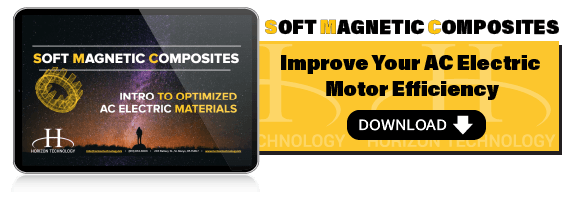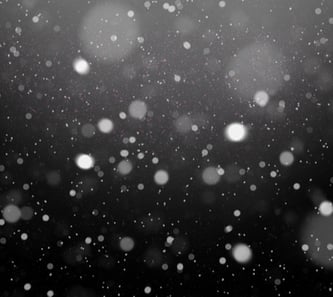Powder metal does more than you might think -- if you’ve got the right material. Knowing the strengths and subtleties of each material process can make your product stand out in a competitive market.
Three emerging material processes you should know about ASAP are the 1P, 3P, and 5P soft magnetic composites.
These terms refer to not only how your vendor processes the parts, but also how it fabricates the material. When you consider 1P, 3P, or 5P for your application, you’re looking at both the raw material itself and the process that allows you to impart certain qualities for better performance
(DYK? The “P” stands for “process.”)
So, what can each material do? And which will most benefit your electromagnetic component?
SMC Options for Electromagnetic Component Design
Soft magnetic composite is an electrically insulated material that represents many of the unique advantages of powder metallurgy. More specifically, 1P, 3P, and 5P are Hoganas' Somaloy 700 line of metal powders, uniquely mixed to improve AC electromagnetic design.
Picking the ideal Somaloy properties is a bit like calling tech support (but much less stressful). Ideally, you start with 1P as a baseline. If your part needs a little more help with its performance, we send you up to level 2 tech support (or in this case, 3P). If that’s still not enough, it’s time to try 5P.
Soft magnetic composite performance is influenced by the powder used, the part’s density, and post-pressing heat treatment. The type of powder used influences the magnetic performance of your part.
Heat Treatment Matters
Heat treatment largely defines the 1P, 3P, and 5P processing alternatives. It helps give the metal impressive magnetic and mechanical strength.
Here’s how we define each material process, including the heat treating involved:
Somaloy 1P
1P means you press the part and process it in a single fashion -- strictly in an air atmosphere. 1P processing is designed to improve the mechanical strength of your electromagnetic component.
Note that despite the name, 1P is still heat treated too. At Horizon, we treat 1P at a maximum temperature of about 500°C. This processing method provides a maximum permeability of about 550.
The 1P soft magnetic composite series is considered the most economical baseline option.
Somaloy 3P
3P means we press your material as before, but take things a bit further.
With 3P we compact your powder, then add a magnetic oxide coating to the particles.
These extra two steps promote higher permeability (up to 700 or even more) with outstanding mechanical strength. The temperature in step two is below the annealing temperature of iron, so core losses are reduced relative to the 1P process, but still not fully optimized ...
Somaloy 5P
A 5P soft magnetic composite is created in a slightly higher-temperature atmosphere containing nitrogen.
The first step in this state-of-the-art process is identical to that of 1P’s and 3P’s. The following step, however, is performed at a temperature that causes your compacted iron powder to anneal.
The benefit of this unique processing? The lowest losses of the three, with permeabilities up to 700 and frequencies up to 1,000 Hz possible.
Warning: 5P is the most expensive of these three options.
What About Your Project?
Soft magnetic composite creates one-of-a-kind shape-making ability -- whether it’s 1P, 3P, or 5P. In turn, that ability gives you:
- Cost savings
- Optimal performance
- Compact design
You’re probably wondering by now which would best fit your project.
Which powder and processing is best for your parts depends on the magnetic performance and mechanical strength required.
Somaloy 1P
The unique characteristics of this material fulfill the requirements of many parts. Here are some examples:
- Ignition coil in automobiles -- the very first soft magnetic composite part!
- Electromagnetic motor design -- co-axial electric motors, unique motor shapes not requiring high strength
- Solenoids -- electromagnetic solenoid designs with a simple in/out function
Somaloy 3P
If moderate core losses and high strength are what you need, then 3P is best for you.
Uses for 3P are similar to those of 1P except that you’re looking for higher strength or slightly higher magnetic performance.
Certain solenoids are classic 3P examples. Why? A solenoid has a given response time. But higher magnetic performance will shorten that response time. So a higher-performing solenoid will stop it faster. Surely you can think of practical uses for that speed!
Certain kinds of AC electric motor designs are great matches for 3P, too. Specifically, you want a higher strength in certain motors so they don’t break. Improved long-term durability is key when you have a part that’s consistently slamming against something else.
Somaloy 5P
These are perfect for applications with medium-high frequency and where heat generation is critical.
Topping that list would be high-performance, high-efficiency, low-loss motors. Think of a brushless DC (BLDC) electric motor. The traditional way of handling these is to use a high-end silicon steel (aka electrical steel) laminate.
Why? These motors tend to have higher operating frequencies. This is where the average lamination steel isn’t enough, so traditionalists move on to silicon electrical steel sheet. But 5P gives you the same benefits of a high-performing silicon steel laminate, with the added shape-making ability.
(Related article: Permanent Magnet Motor vs. Induction Motor Efficiency)
Soft Magnetics: Shaping the Future of Electromagnetic Motor Design
There’s little info out there yet on 1P, 3P, and 5P material methods, so we get it if your head is spinning. Once auto and other industries catch on to the unique electric motor efficiencies these soft magnetic materials offer, that’ll change.
With so little education out there, it’s best to discuss your specific needs with a powder metal parts vendor to optimize electric motor performance and cost. An experienced expert will be able to explain the nuances in material differences and 3-D part shaping. This helping hand can be especially important to those new to leveraging the 3-D shape-making capabilities of soft magnetics.
Only four suppliers in North America use 1P, 3P, and 5P materials. (We're one, and we get it directly from the material source.)
Need more info on improving your electric motor design? The intro-level guide below tells you everything you need to know (and then some) about how SMC materials are used and processed.
(Editor's note: This article was originally published in June 2018 and was recently updated.)




